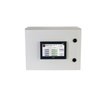Value Snow and Ice Melt Control - 100-240VAC
- Voltage: 100VAC – 240VAC; 50/60 Hz, 16A
- Features NEMA 3R enclosure
- Sensor: built-in snow and temperature sensor
- Automatic and manual override operator controls
- 2-year warranty
Notices
Quebec Repairability Notice
Avis important pour les consommateurs du Québec:
WarmlyYours ne fournit ni services de réparation ni pièces de rechange pour ce produit. Si votre thermostat de chauffage de sol intérieur tombe en panne pendant la période de garantie, nous remplacerons l'unité complète conformément à notre politique de garantie. Notre équipe de soutien technique est disponible par téléphone 24h/24 et 7j/7 pour l'assistance à l'installation et au dépannage. Pour tous les détails, veuillez consulter notre Politique de Retour. Cet avis est fourni conformément à l'article 39 de la Loi sur la protection du consommateur du Québec (telle que modifiée en 2025).
Important Notice for Québec Consumers:
WarmlyYours does not provide repair services or replacement parts for this product. If your indoor floor heating thermostat fails within the warranty period, we will replace the entire unit according to our warranty policy. Our technical support team is available 24/7 by phone for installation and troubleshooting assistance. For full details, see our Return Policy. This notice is provided in accordance with Québec’s Consumer Protection Act, section 39 (as amended in 2025).
Value Snow Melt Control Description
This configurable aerial snow melting controller makes automatic snow melting cost-effective in even the smallest applications. Heaters operate at temperatures below the default set point (38°F or 3.3°C) only when the sensor detects precipitation at temperatures below 38°F. Plus, the adjustable hold-on period (3 hours default) continues heater operation after snow stops to ensure complete melting. The SCV-DUAL controller includes an internal magnetic reed switch used for manual heater cycling, as well as configuring the temperature set point and the hold-on time. The controller operates from 100 to 240 VAC to work with a wide variety of applications. It also controls heater loads up to 16 amps.
Learn more about snow melting systems. Perfect for heated driveways, patios, walkways and paths, accessibility ramps, or even stairs.
Specifications
Warranty / Certifications
| Approvals | cULus listed |
| Area of Use | Non-hazardous locations |
| Warranty | 2 years |
| Waterproofing | NEMA 3R |
Installation
| Best Use | Economic Option For Smaller Projects Under 16 Amps |
Electrical
| Connection Method | Hardwired |
| Control Options | Automatic with manual override |
| Maximum Current | 16 A |
| Maximum Current Description | 16 Amps Max Load |
| Mounting Method | Pole Mounted (sold separately) |
| Sensors | Built-in snow and temperature sensor |
| Voltage | 100 - 240 VAC |
Construction
| Cover material | Polycarbonate |
Product Dimensions
| Diameter | 4.6″ |
| Height | 6.1″ |
| Weight | 1.6 lbs |
Identifiers
| SKU | SCV-DUAL |
| UPC (GTIN-12) | 881308030728 |
Documents
Installation
Technical Information
Wiring Diagrams
- SCV-DUAL Line Wiring Diagram with Relay (English)
- SCV-DUAL without Relay Wiring Diagram for Snow Melting 120–240V (English)
- SCV-Dual with Relay Wiring Diagram (English)
Sell Sheets
- Snow Melt Controller Comparison Sheet Canada (English)
- Snow Melt Relay Panel (English)
- Value SCV-DUAL Snow Melt Control Sell/Specs Sheet (English)
Catalogs
Frequently Asked Questions
The material costs are similar. However, electric systems are easier to install, with fewer components and significantly lower maintenance costs. Electric systems will run for a shorter period of time to give the same level of performance but with much higher energy efficiency (typically 95%-98% efficient). Controls and sensors required for the two types of systems are very similar. Electric systems do not usually require slab insulation and do not create the concerns typically associated with hydronic systems. These concerns include, but are not limited to, return temperatures, flue gas venting, waterway shrinkage and property damage caused by leaking pipes or tubes.
When installing outdoor WarmlyYours snow melting cables for your driveway, patio, walkway, terrace, stairs, ramp, etc. - NEVER cross, overlap, or allow the heating cables to touch each other. Doing so will quickly cause a circuit failure due to excessive heat build up. Always follow the installation instructions and/or design layout plan to ensure the cable is installed with the correct spacing required for proper operation.
Our systems can handle low temperatures, but many controls come equipped with a Low-Temperature Lockout Feature. This feature prevents the system from running in very low temperatures. At very low temperatures it can become difficult for the system to effectively melt the snow. It is however possible to turn off this feature should you need the system to keep running during such low temperatures.




















































